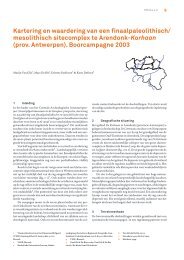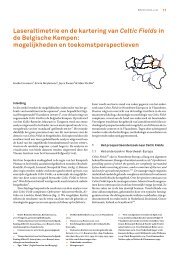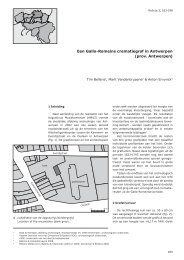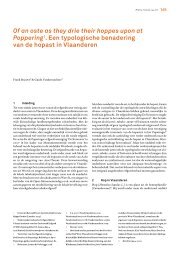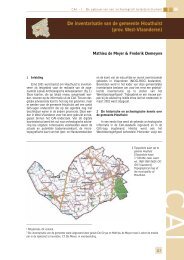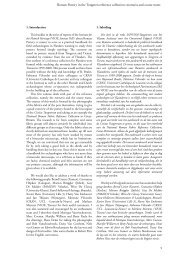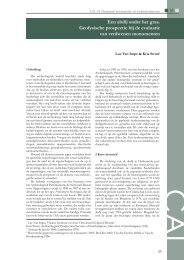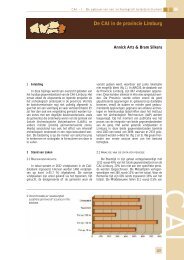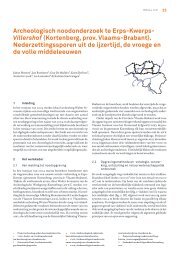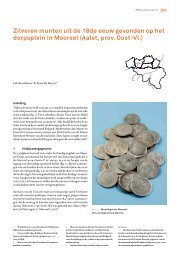Exchanging Medieval Material Culture Studies on archaeology and ...
Exchanging Medieval Material Culture Studies on archaeology and ...
Exchanging Medieval Material Culture Studies on archaeology and ...
Create successful ePaper yourself
Turn your PDF publications into a flip-book with our unique Google optimized e-Paper software.
320<br />
Paul Courtney<br />
important recent trend, infl uenced by American school of<br />
‘new historicist’ literary scholars, has been towards studying<br />
art as ‘texts’ within specifi c social <strong>and</strong> political c<strong>on</strong>texts; especially<br />
the use of art in legitimising the power of oligarchic<br />
elites48. New historicism is heavily infl uenced by both Foucault<br />
<strong>and</strong> Geertz. Its post-modernist emphasis <strong>on</strong> discourse analysis<br />
has also infl uenced the recent work of archaeologist<br />
Matthew Johns<strong>on</strong>, notably his study of the architecture of<br />
Kenilworth Castle49.<br />
In the decorative arts the impact of rising middle class as mass<br />
c<strong>on</strong>sumers of luxury <strong>and</strong> other goods has become a major<br />
focus. Both scholars associated with the Victoria <strong>and</strong> Albert<br />
Museum in L<strong>on</strong>d<strong>on</strong> (<strong>and</strong> its innovative taught MA course), as<br />
well as ec<strong>on</strong>omic historians, have been examining trade networks,<br />
innovati<strong>on</strong>, marketing <strong>and</strong> c<strong>on</strong>sumer markets50. Inspired<br />
by the work of Peter Th ornt<strong>on</strong>51 interior design of the homes<br />
of European elite <strong>and</strong> bourgeoisis has also been a major thread<br />
in recent research52.<br />
2.3 Ec<strong>on</strong>omic <strong>and</strong> local history<br />
(Britain <strong>and</strong> bey<strong>on</strong>d)<br />
Th e period 1880-1920 saw ec<strong>on</strong>omic history appear as a distinct<br />
sub-discipline of history as scholars across Europe tried<br />
to break free of the instituti<strong>on</strong>al dominance of c<strong>on</strong>stituti<strong>on</strong>al<br />
history. In Britain an early c<strong>on</strong>cern with the social c<strong>on</strong>diti<strong>on</strong> of<br />
the working class was refl ected in the historical work <strong>and</strong> activism<br />
of Richard Tawney53 <strong>and</strong> such n<strong>on</strong>-university as the Webbs<br />
<strong>and</strong> Hamm<strong>on</strong>ds54. A major c<strong>on</strong>cern of post-1945 ec<strong>on</strong>omic<br />
historians has been the study of ec<strong>on</strong>omic growth, especially<br />
the origins <strong>and</strong> socio-ec<strong>on</strong>omic impact of the Industrial<br />
Revoluti<strong>on</strong>55. Th e subject was to fi nd especially fertile ground<br />
in the 1960s as the university system exp<strong>and</strong>ed rapidly in the<br />
UK <strong>and</strong> many specialist ec<strong>on</strong>omic history departments were<br />
founded; though, since the 1980s many such departments have<br />
been absorbed within general history schools. In the 1950s <strong>and</strong><br />
1960s, close c<strong>on</strong>necti<strong>on</strong>s grew up between a number of medieval<br />
ec<strong>on</strong>omic historians in Britain, notably Rodney Hilt<strong>on</strong><br />
<strong>and</strong> Maurice Beresford, <strong>and</strong> the archaeologists who pi<strong>on</strong>eered<br />
medieval <strong>and</strong> post-medieval <strong>archaeology</strong>56. Th e fi rst synthesis<br />
of British post-medieval <strong>archaeology</strong> was written by David<br />
Crossley57, an ec<strong>on</strong>omic historian by training, whose special<br />
interest has been early-modern technology <strong>and</strong> industry.<br />
In the 1980s revised fi gures calculated for ec<strong>on</strong>omic growth in<br />
18th-century Britain suggested a slower level of growth than<br />
48 Greenblatt 1991; Jardine 1996b; Gallagher &<br />
Greenblatt 2000.<br />
49 Johns<strong>on</strong> 2002.<br />
50 Mitchell 1997; Berg & Cliff ord 1999; Young<br />
1999; Snodin & Styles 2001; Berg 2005.<br />
51 Th ornt<strong>on</strong> 1978; Idem 1984.<br />
52 Brown 2004; Ajmar-Wollheim & Dennis 2006.<br />
53 Tawney 1926.<br />
54 Feske 1996; Weaver 1997.<br />
55 Harte 1971; Cannadine 1984.<br />
56 Courtney 2006.<br />
57 Crossley 1990.<br />
58 Craft s 1985; Wrigley 1989.<br />
59 Berg & Huds<strong>on</strong> 1992.<br />
60 See also Berg 1994.<br />
61 Crozet 1996; Van der Wee 1996.<br />
62 Berg 2005; Bl<strong>on</strong>dé et al. 2005; Bl<strong>on</strong>dé et al.<br />
2006.<br />
63 Pollard 1981; Duplessis 1997.<br />
64 De Vries & Van der Woude 1995.<br />
65 Mendels 1972; Medick 1976; Houst<strong>on</strong> & Snell<br />
1984.<br />
previously supposed <strong>and</strong> thus a more evoluti<strong>on</strong>ary model of<br />
ec<strong>on</strong>omic <strong>and</strong> industrial transformati<strong>on</strong>58. In resp<strong>on</strong>se, Maxine<br />
Berg <strong>and</strong> Pat Huds<strong>on</strong> argued that the nati<strong>on</strong>al statistics used<br />
underestimated growth59. Th ey reappraised the period 1700-<br />
1830 as a series of multiple transformati<strong>on</strong>s which aff ected specifi<br />
c regi<strong>on</strong>s <strong>and</strong> industries at diff ering time, but which cumulatively<br />
revoluti<strong>on</strong>ised the ec<strong>on</strong>omic <strong>and</strong> social fabric of British<br />
society as a whole60. On the C<strong>on</strong>tinent research <strong>on</strong> industrialisati<strong>on</strong><br />
has been particularly str<strong>on</strong>g in Belgium <strong>and</strong> France<br />
which were the next countries to experience industrialisati<strong>on</strong>61.<br />
Modern ec<strong>on</strong>omic history studies not <strong>on</strong>ly the producti<strong>on</strong> <strong>and</strong><br />
distributi<strong>on</strong> of goods but emphasises retailing <strong>and</strong> household<br />
c<strong>on</strong>sumpti<strong>on</strong>62. Recent work has also tried to place industrializati<strong>on</strong><br />
both within the c<strong>on</strong>text of specifi c regi<strong>on</strong>s <strong>and</strong> simultaneously<br />
the wider framework of European ec<strong>on</strong>omic modernizati<strong>on</strong>63.<br />
Th e Netherl<strong>and</strong>s, for example, transformed from a<br />
‘feudal’ to a modern ec<strong>on</strong>omy without ever experiencing an<br />
Industrial Revoluti<strong>on</strong>64.<br />
A c<strong>on</strong>troversial area of historical research has been <strong>on</strong> the<br />
interacti<strong>on</strong> between western European marriage patterns,<br />
household structure <strong>and</strong> proto-industrialisati<strong>on</strong>65. Th e increasing<br />
role of women <strong>and</strong> children in the work-place has been<br />
seen as crucial to industrial growth by Jan de Vries <strong>and</strong> Maxine<br />
Berg66. However, research <strong>on</strong> specifi c industries has indicated<br />
that women could also be marginalised in the work place by<br />
technical innovati<strong>on</strong>67. Archaeological analysis of household<br />
organisati<strong>on</strong>, producti<strong>on</strong> <strong>and</strong> c<strong>on</strong>sumpti<strong>on</strong> could add a new<br />
perspective to these complex debates. André van Holk, for<br />
example, has noted that fi nds assemblages <strong>on</strong> Dutch polder<br />
ship-wrecks indicate a change from hired to family labour in<br />
the 17th century68.<br />
Archaeologists have begun to follow historians, literary scholars<br />
<strong>and</strong> ec<strong>on</strong>omists in utilising col<strong>on</strong>ial, post-col<strong>on</strong>ial <strong>and</strong><br />
development-theory to underst<strong>and</strong>ing the relati<strong>on</strong>ship between<br />
the industrial world <strong>and</strong> the col<strong>on</strong>ial Th ird World69. Col<strong>on</strong>ial<br />
<strong>and</strong> post-col<strong>on</strong>ial theory has been increasingly applied to the<br />
European periphery especially by American scholars working<br />
<strong>on</strong> native <strong>and</strong> planter settlements in Irel<strong>and</strong>70. However, Audrey<br />
Horning has warned that the oversimplistic applicati<strong>on</strong> of a<br />
binary paradigm has masked complexity <strong>and</strong> ambiguity in the<br />
relati<strong>on</strong>ship between col<strong>on</strong>iser <strong>and</strong> col<strong>on</strong>ized71. Th e increasing<br />
number of Irish post-medieval archaeologists is also beginning<br />
to widen the debate72. Uneven ec<strong>on</strong>omic development is also<br />
oft en associated with col<strong>on</strong>ial <strong>and</strong> post-col<strong>on</strong>ial situati<strong>on</strong>s but<br />
is also found more widely, even within developed regi<strong>on</strong>s73.<br />
66 de Vries 1993; Idem 1994; Maxine Berg 1993.<br />
67 Van Nederveen Meerkerk 2007.<br />
68 van Holk 1996; Idem 1997.<br />
69 Funari et al. 1999a; Given 2004; Gosden 2004;<br />
Lucas 2004; Hicks 2007.<br />
70 Delle 1999; Klingelhofer 1999; Idem 2003;<br />
Orser 2004.<br />
71 Horning 2007.<br />
72 Myles 2006; D<strong>on</strong>nelly et al. 2008.<br />
73 Smith 1984; Harvey 1996; Courtney 2009b.



